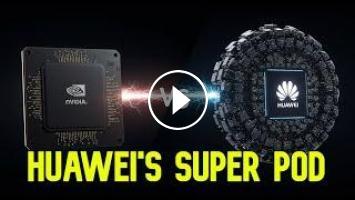Eric Xu's keynote speech at Huawei Connect
https://www.huawei.com/en/news/2025/9/hc-xu-keynote-speech
Join this channel to get access to perks:
https://www.youtube.com/channel/UCGTW3IdzxwSFvPs1RVH6yFA/join
Following the shocking news that Beijing is ditching Nvidia, Huawei has just revealed how it plans to dominate the AI compute race. While Huawei's new Ascend AI chips (950, 960, and 970) are still 1-2 generations behind Nvidia's on a chip-to-chip basis, their secret weapon isn't silicon—it's networking.
At Huawei Connect 2025, the company unveiled its groundbreaking Atlas Super Pods. This new architecture leverages Huawei's world-leading optical interconnect technology to link a staggering 8,000 to 16,000 of their Ascend chips into a single logical machine. This "brute force" approach dwarfs Nvidia's upcoming Vera Rubin NVL144 system, which connects just 144 chips.
Huawei claims this strategy will deliver over 6x the computing power and 62x the interconnect bandwidth of Nvidia's next-generation offerings. We're talking about a single machine with an internal bandwidth 10 times greater than the entire peak of the global internet.
Join RubenTek as we break down the specs, the strategy, and what this means for the US-China tech war. We'll also cover how China's energy dominance makes these power-hungry systems viable and why Huawei's move to fully open-source its AI software stack is a strategic masterstroke to compete with Nvidia's CUDA. Is this the end of Nvidia's dominance?
#Huawei #Nvidia #TechWar #AISupercomputer #HuaweiConnect2025 #ChinaTech
Huawei Ascend, Huawei vs Nvidia, AI Supercomputer, Huawei Connect 2025, China AI Tech, Atlas Super Pod, Nvidia Vera Rubin, AI Chip War, US China Tech War, Interconnect Technology
https://www.huawei.com/en/news/2025/9/hc-xu-keynote-speech
Join this channel to get access to perks:
https://www.youtube.com/channel/UCGTW3IdzxwSFvPs1RVH6yFA/join
Following the shocking news that Beijing is ditching Nvidia, Huawei has just revealed how it plans to dominate the AI compute race. While Huawei's new Ascend AI chips (950, 960, and 970) are still 1-2 generations behind Nvidia's on a chip-to-chip basis, their secret weapon isn't silicon—it's networking.
At Huawei Connect 2025, the company unveiled its groundbreaking Atlas Super Pods. This new architecture leverages Huawei's world-leading optical interconnect technology to link a staggering 8,000 to 16,000 of their Ascend chips into a single logical machine. This "brute force" approach dwarfs Nvidia's upcoming Vera Rubin NVL144 system, which connects just 144 chips.
Huawei claims this strategy will deliver over 6x the computing power and 62x the interconnect bandwidth of Nvidia's next-generation offerings. We're talking about a single machine with an internal bandwidth 10 times greater than the entire peak of the global internet.
Join RubenTek as we break down the specs, the strategy, and what this means for the US-China tech war. We'll also cover how China's energy dominance makes these power-hungry systems viable and why Huawei's move to fully open-source its AI software stack is a strategic masterstroke to compete with Nvidia's CUDA. Is this the end of Nvidia's dominance?
#Huawei #Nvidia #TechWar #AISupercomputer #HuaweiConnect2025 #ChinaTech
Huawei Ascend, Huawei vs Nvidia, AI Supercomputer, Huawei Connect 2025, China AI Tech, Atlas Super Pod, Nvidia Vera Rubin, AI Chip War, US China Tech War, Interconnect Technology
- Category
- Artificial Intelligence
- Tags
- Commentary, Analysis, Opinion












Comments